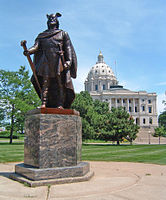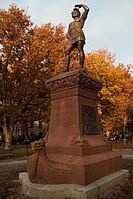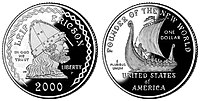Leif Erikson
Leif Erikson | |
|---|---|
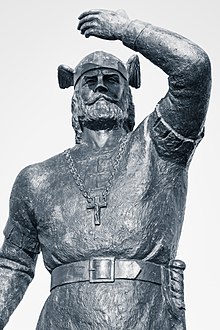 Modern artistic rendering of Leif Erikson inLeif Erikson Park,Duluth, Minnesota | |
| Born | c. 970s[1] |
| Died | c. 1018 to 1025[1] |
| Nationality | Norse:Icelandic |
| Occupation | Explorer |
| Known for | First European inVinland(part of North America; probablyNewfoundland) |
| Partner | Thorgunna (c. 999) |
| Children | 2 |
| Parent(s) | Erik the Red(father) Þjóðhildur (mother) |
| Relatives | Thorvald,Thorstein,andFreydís(siblings) |
Leif Erikson,[note 1]also known asLeif the Lucky(c. 970s– c. 1018 to 1025),[1]was aNorseexplorer who is thought to have been the first European to set foot on continentalAmerica,approximately half a millennium beforeChristopher Columbus.[7][8]According to thesagas of Icelanders,he established aNorse settlementatVinland,which is usually interpreted as being coastal North America. There is ongoing speculation that the settlement made by Leif and his crew corresponds to the remains of a Norse settlement found inNewfoundland, Canada,calledL'Anse aux Meadows,which was occupied approximately 1,000 years ago.
Leif's place of birth is unknown,[9]although it is assumed to have been inIceland.[10][11][12]His father,Erik the Red,founded the firstNorse settlement in Greenland,where Leif was later raised. Following his voyage to Vinland and the subsequent death of his father, Leif became chief of the Greenland settlement. He had two known sons: Thorgils, born in theHebrides;and Thorkell, who succeeded him as Greenland's chieftain.
Early life
Leif was the son ofErik the Redand his wife Thjodhild (Old Norse:Þjóðhildur), and, through his paternal line, the grandson ofThorvald Ásvaldsson.When Erik the Red was young, his father was banished fromNorwayfor manslaughter, and the family went into exile inIceland(which, during the century preceding Leif's birth, had been colonized by Norsemen, mainly from Norway). Leif was also a distant relative ofNaddodd,[13][unreliable source?]who discovered Iceland.[14]
Leif's year of birth is often estimated in thec. 970s.[15]Though his birthplace is not accounted for in thesagas,[16]it is likely he was born in Iceland,[10]where his parents met[17]—probably somewhere on the edge ofBreiðafjörður,and possibly at the farmHaukadal,where his mother's family was based.[10]
Erik was later banished from Iceland and sailed west to a place he namedGreenland.He then briefly returned to Iceland to bring his family and other colonists back with him to Greenland, establishing its first permanent settlement in 986.[16][18]Leif grew up on the family estateBrattahlíðin theEastern Settlementof Greenland. He had two brothers, whose names wereThorsteinandThorvald,and a sister,Freydís.[19]Tyrker,one of Erik'sthralls,had been specially trusted to keep charge of Erik's children, as Leif later referred to him as his "foster father."[20]
Discovering Vinland
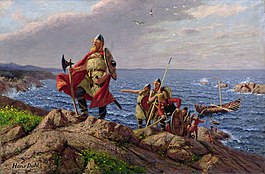
TheSaga of Erik the Redand theSaga of the Greenlanders,both thought to have been written around 1200,[21]contain different accounts of the voyages toVinland(usually interpreted as coastal North America).[22][23]The only two known strictly historical mentions of Vinland are found in the work ofAdam of Bremenc. 1075and in theBook of Icelanders,compiledc. 1122byAri the Wise.[24]
Account in theSaga of Erik the Red

According to this saga, Leif discovered Vinland after beingblown off courseon his way from Norway to Greenland.[25]Before this voyage, Leif had spent time at the court of Norwegian KingOlaf Tryggvesson,where he had converted to Christianity. When Leif encountered the storm that forced him off course, he had been on his way tointroduce Christianityto the Greenlanders. After they had arrived at an unknown shore, the crew disembarked and explored the area. They found wild grapes, self-sown wheat, and maple trees. Afterwards, they loaded their ship with samples of these newly-found goods and sailed east to Greenland, rescuing a group of shipwrecked sailors along the way. For this act, and for convertingNorse Greenlandto Christianity, Leif earned the nickname "Leif the Lucky".[26]Leif did not return to Vinland, but others from Greenland and Iceland did, includingThorfinn Karlsefni.[27]
Account in theSaga of the Greenlanders
According to this saga, Leif was not the first European to discover Vinland. InsteadBjarni Herjólfssonand his crew—on a voyage from Iceland to Greenland—were overtaken by wind and fog, missed the southern tip of Greenland, and encountered an unknown coast. Believing it to be somewhere other than Greenland, they did not disembark but rather continued to sail and found two additional coasts that did not correspond with their understanding of Greenland.[28]After sailing back east, they eventually made it to their original destination, and then told of their discoveries.[29]
Roughly 15 years later, Leif approached Bjarni, purchased his ship, gathered a crew of thirty-five men, and mounted an expedition towards the land Bjarni had described.[30][31]His father Erik was set to join him but dropped out after he fell from his horse on his way to the ship, an incident he interpreted as a bad omen.[32]Leif followed Bjarni's route in reverse and landed first in a rocky and desolate place he namedHelluland(Flat-Rock Land; possiblyBaffin Islandor northern parts of Labrador).[33]After venturing further by sea, he landed the second time in a forested place he namedMarkland(Forest Land; possibly nearCape Porcupine, Labrador).[33]After two more days at sea, he landed on an island to the north (possiblyBelle Isle), and then returned to the mainland, going past a cape on the north side (perhapsCape Bauld).[33]They sailed to the west of this and landed in a verdant area with a mild climate and plentiful supplies of salmon. As winter approached, he decided to encamp there and sent out parties to explore the country.[33]During one of these explorations, Tyrker discovered that the land was full of vines and grapes. Leif therefore named the land Vinland ('Wineland').[33][34]There, he and his crew built a small settlement, which was calledLeifsbudir(Leif's Booths) by later visitors from Greenland.
After having wintered over in Vinland, Leif returned to Greenland in the spring with a cargo of grapes and timber.[30][35]On the return voyage, he rescued an Icelandic castaway and his crew, earning him the nickname "Leif the Lucky".[36]Leif never returned to Vinland, but others from Greenland and Iceland did.
Archeological evidence of Vinland

Most researchers and scholars agree that Vinland was a region in North America.[38]
Research done in the early 1960s by Norwegian explorerHelge Ingstadand his wife, archaeologistAnne Stine Ingstad,identified a Norse site[39]located at the northern tip of Newfoundland. It has been suggested that this site, known asL'Anse aux Meadows(carbon dating estimates 990–1050 CE[40][41][42]andtree-ring analysisdating to the year 1021[43]) could be Leifsbudir. The Ingstads demonstrated that Norsemen had reached North America about 500 years beforeChristopher Columbus.[44][45]Later archaeological evidence suggests that Vinland may have been the areas around theGulf of St. Lawrenceand that the L'Anse aux Meadows site was a ship repair station and waypoint for voyages there. That does not necessarily contradict the identification of L'Anse aux Meadows as Leifsbudir[45][46]since the two sagas appear to describe Vinland as a wider region which included several settlements. TheSaga of Erik the Redmentions two other settlements in Vinland: one calledStraumfjǫrðr,which lay beyond Kjalarnes promontory and theWonderstrands,and one called Hóp, which was located even farther south.[47]
Personal life
Leif has been described in theVinland sagasas a wise, considerate and strong man of striking appearance.[48]When he was of a proper age, Leif went to Norway, likely to serve as aretainerto its king,Olaf Tryggvason.[49]It was on this journey to Norway that theSaga of Erik the Redstates that Leif's ship was driven to theHebrides,where he and his crew were forced to remain for much of the summer, awaiting favorable winds.[50]During his stay there, Leif fell in love with a noblewoman, Thorgunna, who gave birth to their son Thorgils.[19]Thorgunna remained in the Hebrides when Leif left, as he refused to take her along without permission from her family.[51]Thorgils was later sent to Leif in Greenland, but he did not become popular.[52]
After arriving at the court of Norway's King Olaf Tryggvason, Leif was converted to Christianity. According to both theSaga of Erik the Red,andOlaf Tryggvason's Sagaas found inHeimskringla,after Leif's conversion, the king then commissioned him to return to Greenland to convert the settlers there. During the journey, he was blown off course and discovered Vinland before finding his way to Greenland.[27]Leif's father Erik reacted coldly to the suggestion that he should abandon his religion, while his mother Thjóðhildr became a Christian and built a church called Thjóðhild's Church.[53]Adifferent versionofOlaf Tryggvason's Saga,found inFlateyjarbók,makes no reference to Leif being blown off course and discovering Vinland during his return from Norway, but indicates that after arriving in Greenland, all of that country was converted, including Leif's father Erik.[54]Some versions ofOlaf Tryggvason's Sagaalso indicate that to help with the conversion, Leif brought a priest and clerics with him to Greenland.[55]
Chieftaincy and death
The winter following Leif's return from Vinland, his father died (shortly after 1000 CE),[1]making Leif paramount chief in Greenland.[31]Leif is last mentioned alive in 1018 in theSaga of St. Olaf.[1]According toThe Saga of the Sworn Brothers,by 1025 the chieftaincy ofEiríksfjǫrðrhad passed to his son Thorkel.[56][1]Nothing is mentioned about his death in the sagas—he probably died in Greenland some time between these dates.[57]Nothing further is known about his family beyond the succession of Thorkell as chieftain.[1]
Historicity
Leif is, in all likelihood, a historical figure who remains the first known European to set foot in continental North America,[58]but other details of his life vary and are a subject of debate. It has been suggested by several scholars that both Leif's sister, Freydís, and his foster father, Tyrker, are works of fiction, as are their roles in the Vinland sagas.[59]Leif's commission as a missionary to Greenland may also be fictional, as that aspect of his story is often attributed toGunnlaugr Leifsson'sversionofÓláfs saga Tryggvasonar(which likely served as a source for some of the other sagas which mention Leif).[60][31]
Legacy
Norse and medieval Europe

Leif's successful expedition in Vinland encouragedother Norsemen to also make the journey,and the Norse became the first Europeans to colonize the area. In the end there were no permanent Norse settlements, although sporadic voyages at least to Markland for forages, timber and trade possibly lasted for centuries.[61][62]The casual tone of references to these areas may suggest that their discovery was not seen as particularly significant by contemporaries, or that it was assumed to be public knowledge, or both.[24]Knowledge of the Vinland journeys spread around medieval Europe, although to what extent is unclear; writers made mention of remote lands to the west, and notably the medieval chroniclerAdam of Bremendirectly mentions Vinland (c. 1075) based upon reports from theDanes.[note 2]It has been suggested that the knowledge of Vinland might have been maintained in European seaports in the 15th century, and that Christopher Columbus, who claimed in a letter to have visited Iceland in 1477, could have heard stories of it.[63]
Norse encounters with the Indigenous peoples
While Leif had no contact with the Indigenous peoples of Vinland,[64][65]later Norse explorers did, referring to them asskrælingi,an archaic term for "wretches".[66]
According to theSaga of Erik the Red,the first encounter was made during a colonizing expedition led by Thorfinn Karlsefni, which also included Leif's brother Thorvald. At first this group traded with the natives, but weeks later the new Norse settlement at Hóp was attacked and Karlsefni decided to abandon it. The Norse retreated to their other settlement at Straumfjǫrðr, where they remained and continued to explore the general area. One morning they encountered aone-leggednative, who shot an arrow that killed Thorvald.[64]He is famously known for pulling the arrow out, and poetically reciting the phrase, "This is a rich country we have found; there is plenty of fat around my entrails", upon which he dies.[66]On their return to Greenland, Karlsefni's crew captured two native boys, taking them to Greenland.[64]
According to theSaga of the Greenlanders,Leif's brother Thorvald made first contact with the natives.[63]The encounter happened while Thorvald and his crew were exploring the coast, likely in the Markland area, and found nine natives asleep under boats. They attacked the natives, killing eight of them, while one escaped. Shortly after, in an apparent reprisal, Thorvald was killed by a native's arrow. Later, Thorfinn Karlsefni led a group to colonize Vinland and encountered natives, who they initially traded with, but relations soured when a native was killed attempting to steal weapons from the Norse. In retaliation, the natives attacked and Karlsefni decided to abandon the colony.[64]
Travels and commemoration

Stories of Leif's journey to North America had a profound effect on the identity and self-perception of laterNordic Americansand Nordic immigrants to the United States.[18]The firststatue of Erikson(byAnne Whitney)[67]was erected inBostonin 1887 at the instigation ofEben Norton Horsford,who was among those who believed that Vinland could have been located on theCharles RiverorCape Cod;[18]not long after,another casting of Whitney's statuewas erected inMilwaukee.[68]A statue was also erected inChicagoin 1901, having been originally commissioned for the 1893World's Columbian Expositionto coincide with the arrival of the reconstructedViking shipfromBergen,Norway.[18]Another work of art made for the 1893 World's Columbian Exposition, the paintingLeiv Eirikson Discovering AmericabyChristian Krohg,was in the possession of a Leif Erikson Memorial Association in Chicago before being given back to theNational Gallery of Norwayin 1900.[69]
For the centenary of the first official immigration of Norwegians to America, PresidentCalvin Coolidgestated at the 1925Minnesota State Fair,to a crowd of 100,000 people, that Leif had indeed been the first European to discover America.[18]Additional statues of him were erected at theMinnesota State CapitolinSt. Paulin 1949, nearLake SuperiorinDuluth, Minnesota,in 1956, and in downtownSeattle.[18]
In 1924, a party of four consisting of a Swede, an Englishman, and two Americans attempted to emulate Leif's voyage in an eponymous 40-foot vessel but were lost after reaching the west coast of Greenland.[70]: 267
In 1930, astatue of Leifwas erected in the city center of Reykjavík, Iceland – currently situated in front ofHallgrímskirkja– as a gift from the United States to Iceland to commemorate the 1,000 year anniversary ofAlþingi,the parliament of Iceland.[71]
TheLeif Erikson Awards,established 2015, are awarded annually by theExploration MuseuminHúsavík,Iceland. They are awarded for achievements in exploration and in the study of the history of exploration.[72]
Several ships are named after Leif –a Viking ship replica,a commercial passenger/vehicle ferry,[73][74]and a largedredger.[75]
Erikson is recalled asLeif the Luckyin theRobert FrostpoemWild Grapes.[76]
Leif Erikson Day
In 1929, theWisconsin Legislaturepassed a bill to make 9 October "Leif Erikson Day" in the state, and in the years following, several other states adopted laws to observe the day.[77]In 1935, legislation was introduced to theUnited States Congressrequesting federal observance of the day. Before the legislation was passed, it was amended so that the observance would only occur in 1935[78](which it was, following a proclamation that year by President PresidentFranklin D. Roosevelt).[79]In the subsequent decades, a number of unsuccessful attempts were made to pass legislation requesting Leif Erikson Day be proclaimed annually by the president.[80]Proponents eventually succeeded, when, in 1964, the Congress authorized and requested the president to proclaim 9 October of each year as "Leif Erikson Day".[18]In the years since, each president has issued an annual proclamation calling for observance of the day.[81]
The Sagas do not give the exact date of Leif's landfall in America, but state only that it was in the fall of the year. At the suggestion of Christian A. Hoen ofEdgerton, Wisconsin,9 October was settled upon for Leif Erikson Day, as that already was a historic date for Norwegians in America, the shipRestaurationenhaving arrived inNew York Harboron 9 October 1825[77][82]fromStavangerwith the first organized party of Norwegian immigrants.[83]
Gallery of art and sculptures
-
Leif Erikson memorial statueat Shilshole Bay Marina,Port of Seattle
-
Leif Eriksson Memorial(1929–1932),Reykjavík, Iceland.This statue is at the front of theHallgrímskirkja.There is a copy of this statue inNewport News, Virginia,USA.[84]
-
Leif Erikson byJohn K. Daniels,1948–49, near theMinnesota State Capitol.
-
Theoldest public statue of Leif,placed inBostonin 1887.
-
A 'Leif Ericson'proof dollarfrom the United States, minted in 2000. It reads 'Founder of the New World'
In fiction

- Leif is the main character in the 1928 filmThe Viking.[85]
- In children's literature, Leif the Lucky written and illustrated byIngri and Edgar Parin d'Aulaire.Published by Doubleday & Company, Inc., 1941.[86]
- Leif is one of the main characters inMakoto Yukimura'smangaVinland Saga.[87]
- Leif is the main character in the juvenile historical novelVinland the Good.The author isHenry Treece,and it is illustrated by William Stobbs. It is an account of Viking Era explorations, based mainly on the Greenland saga.[88]
- An Old Captivityis a novel which involves a dream sequence featuring a character called Leif Ericson. Notably, it also features an attempt to uncover historical Viking settlements using air surveys. It was written byNevil Shuteand published in 1940.[89]
- Leif is a main character in theNetflixhistorical dramaseriesVikings: Valhallaplayed bySam Corlett.[90]
See also
- Leif Erikson Awards
- Leif Ericson Millennium commemorative coins
- Alonso Sánchez,a Spanish navigator who purportedly visited the Americas before Columbus
- Saint Brendan,a legendary Irish navigator
- Jean Cousin,a French navigator with a similar claim
- Kunyu Wanguo Quantu,1602 Chinese world map purportedly transcribed with Chinese data from 1430
Notes
- ^ThepatronymisAnglicizedin various ways in the United States; according to one source,Leif Ericsonis the most common rendering on theEast Coast,whileLeif Eriksonis the most common rendering on theWest Coast.[2]Eriksonis the spelling widely used and recognized by many others.[3][4][5][6]Old Norse:Leifr Eiríksson[ˈlɛivz̠ˈɛiˌriːksˌson];Icelandic:Leifur Eiríksson[ˈleiːvʏrˈeiːˌriksˌsɔːn];Norwegian:Leiv Eiriksson;Swedish:Leif Eriksson;Danish:Leif Eriksen
- ^Adam mentions Vinland (Winland) in Chapter 39 of Book IV of hisGesta:'In addition, he [i.e.,Sweyn Estridsson,king of Denmark (reigned 1047–1076)] named one more island in this ocean, discovered by many, which is called "Vinland", because vines grow wild there, making the best wine. For [that] crops [that are] not sown, abound there, we learn not from fanciful opinion but from the true account of the Danes.'Adam von Bremen (1917). Schmeidler, Bernhard (ed.).Hamburgische Kirchengeschichte[Hamburg's Church History] (in Latin and German). Hannover and Leipzig, Germany: Hahnsche. pp. 275–276.
References
- ^abcdefg"Leif Eriksson".The Canadian Encyclopedia.12 October 2018.Archivedfrom the original on 13 April 2021.Retrieved6 March2023.
- ^Leander, Kristine (2008).Norwegian Seattle.Arcadia Publishing. p. 63.ISBN978-0-7385-5960-5.Archivedfrom the original on 28 April 2022.Retrieved19 November2015.
- ^"Turning over a new Leif".Leif Erikson International Foundation.Archivedfrom the original on 26 December 2018.Retrieved23 March2014.
- ^Leif Erikson Issue.Smithsonian Institution. Archived fromthe originalon 2 February 2016.Retrieved23 March2014.
- ^"History".Sons of Norway. Archived fromthe originalon 26 December 2018.Retrieved23 March2014.
- ^Norwegian-American Studies, Volumes 1–3.Norwegian-American Historical Association. 1926.Archivedfrom the original on 15 August 2021.Retrieved11 October2020.
- ^"Leif Erikson (11th century)".BBC.Archivedfrom the original on 6 October 2018.Retrieved20 November2011.
- ^"Why Do We Celebrate Columbus Day and Not Leif Erikson Day?".National Geographic.11 October 2015. Archived fromthe originalon 26 December 2018.Retrieved12 October2015.
- ^Leiv ErikssonArchived5 August 2017 at theWayback Machine,Norsk biografisk leksikon
- ^abcSverrir Jakobsson (14 July 2001)."Shouldn't Leifr Eiríksson ('Leif the Lucky') really be viewed as a Greenlander with family roots in Iceland and Norway?".Translated by Nicholas Jones, 25 November 2005. The Icelandic Web of Science.Archivedfrom the original on 3 January 2022.Retrieved3 January2022.
- ^Leif ErikssonArchived3 October 2013 at theWayback Machine– Encyclopædia Britannica, Inc., 2012. Retrieved 11 April 2012.
- ^"Congressional Record, V. 145, Pt. 21, November 17, 1999 to December 3, 1999".Government Printing Office.Archivedfrom the original on 9 October 2021.Retrieved11 October2020– via Google Books.
- ^"Thorvald Asvaldsson | Mediander | Connects".Mediander.Archived fromthe originalon 28 August 2017.Retrieved26 October2015.
- ^"The Discovery of Iceland".www.viking.no.Archivedfrom the original on 11 July 2011.Retrieved26 October2015.
- ^Regal, B. (2022).The Battle over America's Origin Story: Legends, Amateurs, and Professional Historiographers.Springer International Publishing. p. 107.ISBN978-3-030-99538-6.Archivedfrom the original on 10 April 2023.Retrieved6 March2023.
- ^ab"Leiv Eiriksson".Store norske leksikon(in Norwegian).Archivedfrom the original on 5 August 2017.Retrieved13 November2011.
- ^Sanderson, Jeanette. (2002)Explorers,Teaching Resources/Scholastic. p. 14.ISBN0-439-25181-8.
- ^abcdefgDregni, Eric(2011).Vikings in the attic: in search of Nordic America.U of Minnesota Press. pp. 72–73.ISBN978-0-8166-6744-4.Archivedfrom the original on 21 May 2022.Retrieved19 November2015.
- ^abIngstad, Helge;Ingstad, Anne Stine(2000).The Viking discovery of America: the excavation of a Norse settlement in L'Anse aux Meadows, Newfoundland.Breakwater Books. p. 74.ISBN978-1-55081-158-2.Archivedfrom the original on 24 February 2022.Retrieved19 November2015.
- ^Wiesner-Hanks, Merry E.;Wheeler, William Bruce; Doeringer, Frankli n; Curtis, Kenneth R. (2011).Discovering the Global Past.Cengage Learning. p. 158.ISBN978-1-111-34142-8.Archivedfrom the original on 23 May 2022.Retrieved19 November2015.
- ^Lindkvist, Thomas (2003). "Early political organisation". In Helle, Knut (ed.).The Cambridge History of Scandinavia: Prehistory to 1520.Cambridge University Press. p. 212.ISBN978-0-521-47299-9.
- ^Somerville & McDonald, 2010, p. 350.
- ^Short, 2010, p. 203.
- ^ab"Vinland History".National Museum of Natural History.Smithsonian Institution.Archived fromthe originalon 26 November 2011.Retrieved23 November2011.
- ^Somerville & McDonald, 2010, pp. 419–420.
- ^Ingstad, 1985, pp. 171–178.
- ^abCampbell, 2021, pp. 37–39.
- ^Ingstad, 1985, pp. 101–106.
- ^Campbell, 2021, pp. 35–37.
- ^abShort, 2010, pp. 203–204.
- ^abcWallace, 2006, p. 19
- ^Somerville & McDonald, 2010, p. 352.
- ^abcdeWernick, Robert (1979).The Vikings.Alexandria, VA: Time-Life Books. pp.149–151.ISBN0-8094-2709-5.
- ^Kudeba, N. (19 April 2014).Chapter 5 – Norse Explorers from Erik the Red to Leif Erikson – Canadian Explorers.Retrieved from The History of Canada:"Chapter 5 – Norse Explorers from Erik the Red to Leif Erikson – Canadian Explorers | the History of Canada".Archived fromthe originalon 8 May 2014.Retrieved22 April2014.
- ^Somerville & McDonald, 2010, pp. 352–354.
- ^Somerville & McDonald, 2010, p. 354.
- ^Handwerk, Brian."New Dating Method Shows Vikings Occupied Newfoundland in 1021 C.E."Smithsonian Magazine.Smithsonian Institution.Archivedfrom the original on 7 April 2022.Retrieved10 April2022.
- ^Cassidy, Cody(2020).Who Ate the First Oyster?: The Extraordinary People Behind the Greatest Firsts in History.New York:Penguin Books.p. 84.ISBN978-0-14-313275-2.
- ^"L'Anse aux Meadows".L'Anse aux Meadows National Historic Site of Canada.Parks Canada. 2018.Archivedfrom the original on 9 December 2019.Retrieved21 December2018.
Here [L'Anse aux Meadows] Norse expeditions sailed from Greenland, building a small encampment of timber-and-sod buildings...
- ^Nydal, Reidar (1989)."A Critical Review of Radiocarbon Dating of a Norse Settlement at L'Anse Aux Meadows, Newfoundland Canada".Radiocarbon.31(3): 976–985.Bibcode:1989Radcb..31..976N.doi:10.1017/S0033822200012613.eISSN1945-5755.ISSN0033-8222.Archivedfrom the original on 22 November 2021.Retrieved2 December2021.
With an assumed total systematic error of 30 ± 20 years, as a mean for various tree rings, the calibrated age range of L'Anse aux Meadows is AD 975–1020. This agrees well with the assumed historical age of ca AD 1000, a result which has also been recently corroborated by high-precision accelerator dating at the University of Toronto.
- ^Cordell, Linda S.;Lightfoot, Kent; McManamon, Francis; Milner, George (2009)."L'Anse aux Meadows National Historic Site".Archaeology in America: An Encyclopedia.ABC-CLIO. p. 82.ISBN978-0-313-02189-3.Archivedfrom the original on 30 December 2016.Retrieved24 February2021.
This is a substantial base for analysis, which yields an entirely credible range of dates between 990 and 1050 and a mean date of 1014 CE, which is popularly rounded off at 1000 CE.
- ^Ledger, Paul M.; Girdland-Flink, Linus; Forbes, Véronique (15 July 2019)."New horizons at L'Anse aux Meadows".Proceedings of the National Academy of Sciences.116(31): 15341–15343.Bibcode:2019PNAS..11615341L.doi:10.1073/PNAS.1907986116.eISSN1091-6490.ISSN0027-8424.PMC6681721.PMID31308231.
Modeling results were remarkably consistent, and model A suggests Norse occupation began Cal AD 910–1030..... A weighted mean of twig dates—notwithstanding issues associated with combination of 14C ages from multiple individuals—provided a result of AD 986–1022
- ^Kuitems, Margot; Wallace, Birgitta L.; Lindsay, Charles; Scifo, Andrea; Doeve, Petra; Jenkins, Kevin; Lindauer, Susanne; Erdil, Pınar; Ledger, Paul M.; Forbes, Véronique; Vermeeren, Caroline (20 October 2021)."Evidence for European presence in the Americas in AD 1021".Nature.601(7893): 388–391.doi:10.1038/s41586-021-03972-8.ISSN1476-4687.PMC8770119.PMID34671168.S2CID239051036.
Our result of AD 1021 for the cutting year constitutes the only secure calendar date for the presence of Europeans across the Atlantic before the voyages of Columbus. Moreover, the fact that our results, on three different trees, converge on the same year is notable and unexpected. This coincidence strongly suggests Norse activity at L'Anse aux Meadows in AD 1021. In addition, our research demonstrates the potential of the AD 993 anomaly in atmospheric 14C concentrations for pinpointing the ages of past migrations and cultural interactions.
- ^"Helge Ingstad".The Telegraph.30 March 2001.Archivedfrom the original on 11 January 2022.Retrieved20 November2011.
- ^abShort, 2010, p. 207.
- ^"Vinland Archeology".National Museum of Natural History.Smithsonian Institution.Archivedfrom the original on 9 December 2003.Retrieved21 November2011.
- ^"Vinland Sagas".National Museum of Natural History.Smithsonian Institution.Archivedfrom the original on 23 December 2015.Retrieved21 November2011.
- ^"Leif Eriksson | The Canadian Encyclopedia".www.thecanadianencyclopedia.ca.Archivedfrom the original on 13 April 2021.Retrieved24 February2021.
- ^Wallace, 2006, pp. 17,19.
- ^Saga of Eric the Redin Reeves, 1890, p. 35.
- ^Saga of Eric the Redin Reeves, 1890, pp. 35–36.
- ^"Leif Eiriksson," Leif the Lucky "(Leifr Eiríksson, nicknamed, Leifr hin heppni)".Great Unsolved Mysteries in Canadian History: Where is Vinland?.Archivedfrom the original on 9 December 2016.Retrieved21 November2011.
- ^Somerville & McDonald, 2010, p. 420.
- ^Reeves, 1890, p. 57.
- ^Hermannsson, Halldór (June 1954)."Tyrkir, Leif Erikson's Foster-Father".Modern Language Notes.69(6). Johns Hopkins University Press: 388–389.doi:10.2307/3039733.ISSN0149-6611.JSTOR3039733.Archivedfrom the original on 12 December 2022.Retrieved11 December2022.
- ^Seaver, Kirsten A. (1997).The frozen echo: Greenland and the exploration of North America, ca. A.D. 1000–1500.Stanford University Press. p. 62.ISBN978-0-8047-3161-4.Archivedfrom the original on 20 December 2019.Retrieved19 November2015.
- ^Hermannsson, Halldór (1936).The problem of Wineland, Volume 1; Volume 25.Cornell University Press.ISBN978-0527003555.Archivedfrom the original on 19 August 2021.Retrieved19 November2015.
- ^Wallace, 2006, p. 17.
- ^Perkins, Richard (2004)."Medieval Norse visits to America: Millennial Stocktaking"(PDF).Saga-Book.XXVIII:47–48, 53.ISSN0305-9219.JSTOR48612649.Archived(PDF)from the original on 2 February 2023.Retrieved1 January2023.
- ^Grønlie, Siân (2006).Íslendingabók; Kristni saga: The Book of Icelanders; The Story of the Conversion(PDF).Text Series. Vol. XVIII. London: Viking Society for Northern Research. pp. xxxiv, 68.ISBN0-903521-71-7.Archived(PDF)from the original on 12 April 2013.Retrieved1 January2023.
- ^Schledermann, Peter. (1996). Voices in Stone.A Personal Journey into the Arctic Past.Komatik Series no. 5. Calgary: The Arctic Institute of North America and the University of Calgary.
- ^Sutherland, Patricia. (2000). "The Norse and Native Norse Americans". In William W. Fitzhugh and Elisabeth I. Ward, eds.,Vikings: The North Atlantic Saga,pp. 238–247. Washington, DC: The Smithsonian Institution.
- ^abShort, 2010, pp. 203–206.
- ^abcdMcGhee, Robert (January 1984). "Contact between Native North Americans and the Medieval Norse: A Review of the Evidence".American Antiquity.49(1): 4–26.doi:10.2307/280509.JSTOR280509.S2CID163333983.
- ^Warden, Donald E. (August 2016)."The Extent of Indigenous-Norse Contact and Trade Prior to Columbus".Oglethorpe Journal of Undergraduate Research.6(1).Archivedfrom the original on 18 December 2021.Retrieved18 December2021.p. 7:
Leif did not encounter any Indigenous people over the entire voyage
- ^abWeaver, Jace (2011).The red atlantic.American Indian Quarterly. pp. 418–463, 477.
- ^Forbes, Alanand Ralph M. Eastman, "Some Statues of Boston: Reproductions of some of the statues for which Boston is famous, with information concerning the personalities and events memorialized", State Street Trust Company, Boston MA 1946 and Forbes, Alan and Ralph M. Eastman, "Other Statues of Boston", State Street Trust Company, Boston MA 1947.
- ^Buck, Diane M; Palmer, Virginia A (1995).Outdoor Sculpture in Milwaukee: A Cultural and Historical Guidebook.Madison: The State Historical Society of Wisconsin. pp. 9–12.ISBN978-0-87020-276-6.
- ^"Leiv Eiriksson oppdager Amerika".Store norske leksikon(in Norwegian). Oslo: Kunnskapsforlaget.Archivedfrom the original on 4 October 2013.Retrieved2 December2011.
- ^Thomas, Lowell(1925).The First World Flight.Boston & New York: Houghton Mifflin Company.
- ^Helgason, Magnús Sveinn; Eliason, Matt; McMahon, Sara; Sigurþórsdóttir, Sunna Karen (2 November 2015)."Ten fascinating facts about the statue of Leifur Eiríksson".Icelandmag.Archivedfrom the original on 8 March 2021.Retrieved16 June2020.
- ^"The Exploration Awards – The Exploration Museum".Archivedfrom the original on 31 March 2022.Retrieved30 March2022.
- ^"MV Leif Ericson Ferry – Vessel Information | Marine Atlantic".www.marineatlantic.ca.Archivedfrom the original on 19 March 2021.Retrieved30 March2021.
- ^"Leif Ericsson (Ro-Ro/Passenger Ship) Registered in Canada – Vessel details, Current position and Voyage information – IMO 8917388, MMSI 316001216, Call Sign VOCJ".www.marinetraffic.com.Archivedfrom the original on 15 April 2021.Retrieved30 March2021.
- ^"The world's largest dredger in the Gulf of Gdansk".Poland at Sea – maritime economy portal.11 June 2019.Archivedfrom the original on 25 February 2020.Retrieved30 March2021.
- ^"Wild Grapes Robert Frost 1874 – 1963".Poets.org.
Grapes, I knew grapes from having seen them last year.
One bunch of them, and there began to be
Bunches all round me growing in white birches,
The way they grew round Leif the Lucky's German; - ^abHansen, Carl Gustav Otto(1956)."Leif Erikson Comes to the Front".My Minneapolis.Minneapolis. Archived fromthe originalon 7 December 2009.
{{cite book}}:CS1 maint: location missing publisher (link) - ^"Leif Erikson Day Oct. 9 Proclaimed".The Green Bay Press-Gazette.Green Bay, WI. 16 September 1935. p. 5.
- ^Roosevelt, Franklin D."The Statutes at Large of the United States of America from January 1935 to June 1936. Vol 49, part 1, pages 3468–3469".Government Printing Office.
- ^Tollefson, Thor C.(4 March 1964).Leif Erikson Day: Hearings before Subcommittee No. 4 of the Committee on the Judiciary. House of Representatives(Report). Washington: U.S. Government Printing Office. p. 5.Retrieved30 July2023.
For quite a few years, and even prior to the time that I first came to Congress, similar resolutions had been introduced, seeking to have October 9 declared Leif Erikson Day. All of the previous efforts have been unsuccessful.
- ^Guttormsen, Torgim Sneve (2018). "Valuing Immigrant Memories as Common Heritage: The Leif Erikson Monument in Boston".History & Memory.30(2). Indiana University Press: 99.doi:10.2979/histmemo.30.2.04.S2CID166186978.
- ^Obama, Barack(7 October 2009)."Leif Erikson Day, 2009"(Press release).White House Office of the Press Secretary.Archivedfrom the original on 14 February 2017.Retrieved20 November2011.
- ^Aarek, Hans Eirik (2000). "A Short History of the Troms Quakers And their Emigration to America".Norwegian-American Studies.35.University of Minnesota Press: 92.doi:10.1353/nor.2000.a799212.S2CID258610849.
Conflict with the Norwegian authorities was one of the main motivations for emigrating to America. Quakers were not allowed to live everywhere in Norway...This led to the first organized emigration in 1825.
- ^"Leif Erikson statue".alamy.Archivedfrom the original on 13 July 2020.Retrieved13 July2020.
- ^Hall, Mordaunt(29 November 1928)."A Picture in Colors".The New York Times.New York City.Archivedfrom the original on 12 July 2020.Retrieved30 November2019.
- ^"Leif the Lucky".Adlibris(in Swedish). 15 October 2014.Archivedfrom the original on 22 September 2022.Retrieved20 April2022.
- ^Harris, Will (31 July 2019)."Amazon's Vinland Saga Anime Is a Classic Anime in the Making".IGN Southeast Asia.Archivedfrom the original on 9 January 2021.Retrieved22 August2020.
- ^William Stobbs, Henry Treece."Vinland the Good".childrensbookshop.com.Puffin.Archivedfrom the original on 7 March 2021.Retrieved23 August2020.
- ^Shute, Nevil."An Old Captivity".fadedpage.com.William Morrow & Company.Archivedfrom the original on 13 August 2020.Retrieved23 August2020.
- ^"Sam Corlett Gets Spiritual as Leif Eriksson in 'Vikings: Valhalla'".Netflix Tudum.1 March 2022.Archivedfrom the original on 31 March 2022.Retrieved31 March2022.
Bibliography
- Campbell, Gordon(2021).Norse America: The Story of a Founding Myth.Oxford: Oxford University Press.ISBN978-0-19-886155-3.
- Ingstad, Helge(1985).The Norse Discovery of America (Volume 2): The Historical Background and the Evidence of the Norse Settlement Discovered in Newfoundland.Oslo: Norwegian University Press (Universitetsforlaget AS).ISBN82-00-07039-5.
- Reeves, Arthur Middleton(1890).The finding of Wineland the Good: the history of the Icelandic discovery of America.London: H. Frowde, Oxford University Press.
- Short, William R. (2010).Icelanders in the Viking age: the people of the sagas.McFarland.ISBN978-0-7864-4727-5.Archivedfrom the original on 21 May 2022.Retrieved19 November2015.
- Somerville, Angus; McDonald, Andrew R. (2010).The Viking Age: A Reader.University of Toronto Press.ISBN978-1-4426-0148-2.Archivedfrom the original on 24 January 2021.Retrieved19 November2015.
- Wallace, Birgitta Linderoth(2006).Westward Vikings: The Saga of L'Anse aux Meadows.St. John's, NL: Parks Canada and the Historic Sites Association of Newfoundland and Labrador.ISBN0-919735-09-6.
External links
 Media related toLeifur Eiríkssonat Wikimedia Commons
Media related toLeifur Eiríkssonat Wikimedia Commons- Works about Leif EriksonatOpen Library
- Beazley, Charles Raymond(1911)..Encyclopædia Britannica.Vol. 16 (11th ed.). p. 396.
- Leif Erikson
- 970s births
- 1020s deaths
- 10th-century Christians
- 10th-century Icelandic people
- 11th-century Christians
- 11th-century Icelandic people
- Converts to Christianity from Germanic paganism
- Greenlandic Christians
- Explorers of Canada
- Icelandic explorers
- Icelandic sailors
- Viking Age in Canada
- Scandinavian explorers of North America
- Viking explorers
- 10th-century explorers
- 10th-century Vikings
- Norse settlements in Greenland


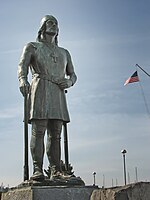
![Leif Eriksson Memorial (1929–1932), Reykjavík, Iceland. This statue is at the front of the Hallgrímskirkja. There is a copy of this statue in Newport News, Virginia, USA.[84]](https://upload.wikimedia.org/wikipedia/commons/thumb/6/6e/Leifur_heppni_%28603381304%29.jpg/150px-Leifur_heppni_%28603381304%29.jpg)
